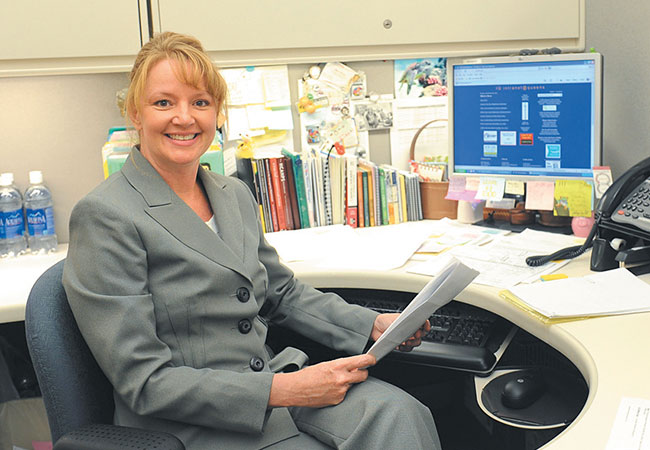ER Services: Behind The Scenes
Julie Hussey,
Director of emergency services at The Queen’s Medical Center-West Oahu
Where did you receive your schooling and training?
I attended Indiana University for my Bachelor of Science in nursing while working as a student nurse extern in the emergency department at Wishard Memorial Hospital, a Level 1 trauma center (having the highest level of care, with the most sophisticated equipment, and surgeons with specialized training) in Indianapolis. I continued at Wishard as an ED R.N. (emergency department registered nurse) following graduation prior to moving to Hawaii in 2001, when I began working for The Queen’s Medical Center. My experience is with both Level 1 and Level 2 trauma centers.
How long have you been in practice?
I completed my B.S.N. in 1992, so 21 years now -18 years in the ED, and two-and-a-half years in cardiopulmonary rehab.

Julie Hussey, emergency department director for The Queen’s Medical Center-West Oahu | Lawrence Tabudlo photos
What does the regimen for emergency services personnel look like on a daily basis?
The emergency department is a dynamic, ever-changing environment. During the course of any day, staff cares for patients with chief complaints ranging from non-acute, non-urgent cough, cold and flu symptoms, minor lacerations and sprains, to acute, emergent cases such as traumas, heart attacks, strokes and everything in between. The team of an ED physician, R.N. and ER (emergency room) technician coordinate the care of each patient to assure the patient’s medical needs are thoroughly addressed, and also assist with the patient’s and family’s social needs with the help of case managers and social workers. In addition, ancillary services support the ED by providing respiratory therapy service, imaging services, and consulting M.D. (medical doctor) specialty services also are available for specific diagnosis and treatment.
What are your particular duties?
I provide and oversee R.N. and ER technicians and secretary staffing and training needs. I ensure the ED staff are current on competencies and certifications necessary for the specialty of emergency department nursing. I develop initiatives and processes to improve efficiency and throughput of patients for either admission or discharge. I monitor nursing care and documentation to ensure the standards of care are delivered with consistency. I work with nursing staff on committees to continuously improve and develop the nursing process. I work in collaboration with the ED physician group to refine protocols, and continuously work to improve patient care and satisfaction. I work with the managers of the other departments in the hospital to coordinate patient care and manage or follow up on any situations that arise. I also work with the EMS (emergency medical service) related to pre-hospital services and transfer/transport needs to other facilities. In addition, I am responsible for the budget of the department, equipment needs, and represent the ED in hospital-wide committees.
What conditions constitute emergency need?
Any condition or situation in which a patient’s airway, breathing or circulation is compromised, or if the patient presents an imminent risk of harm to themselves or others.
What are some of the most common reasons people end up in emergency care?
• Accidents: car, skateboard, surfing, bicycle, motorcycle
• Worsening chronic medical conditions: chronic obstructive pulmonary disease, pneumonia
• Cardiac: rhythm changes, heart attacks, chest pain
• Neurological changes: stroke, altered mental status, transient ischemic attacks (mini-stroke)
• Sepsis: severe infections, complications from impaired immune system
The ED also is frequently used for less urgent cases: abdominal pain, flu symptoms, sprains, lacerations, orthopedic injuries from falls, etc.
When someone arrives in an emergency situation, what happens next?
The patient may arrive by private car or ambulance. If by ambulance, the paramedics call ahead to the hospital to give an initial report to allow the hospital to prepare for the patient’s arrival and secure the necessary resources to attend to the particular emergency situation – cardiac arrest, trauma, stroke, heart attack, difficulty breathing, emergent delivery of a baby, psychiatric cases (overdoses, violent patients, self-inflicted injuries).
The patient is then seen by an R.N. and triaged – assessed to determine acuity and urgency to be seen by a physician. Heart rate and rhythm, blood pressure, temperature, oxygen saturation, mental status, ability to move and communicate are the vital signs and patient assessments performed on arrival. The nurse will then coordinate the patient’s care with the ED physician to assure all necessary resources and team members are alerted to respond to the ED to participate in the care of the patient.
At what point might the person be transferred to regular care?
When the patient has been stabilized: Vital signs are within normal limits; any compromise to the patient’s airway, breathing or circulation has been managed; the patient’s mental status and level of consciousness has returned to baseline.





